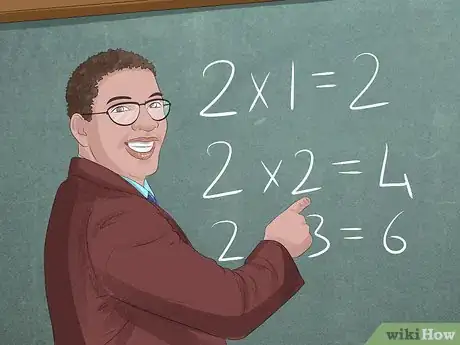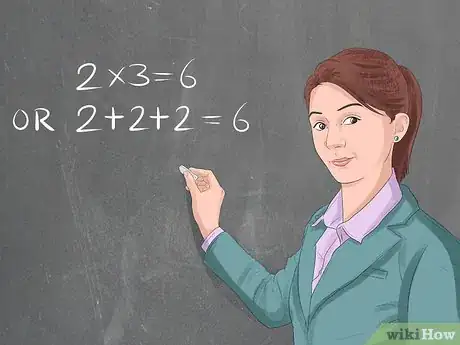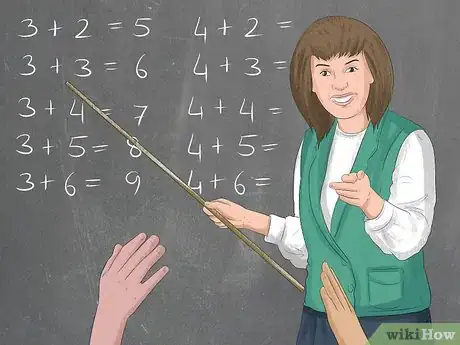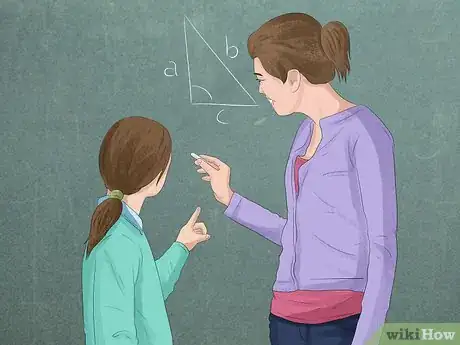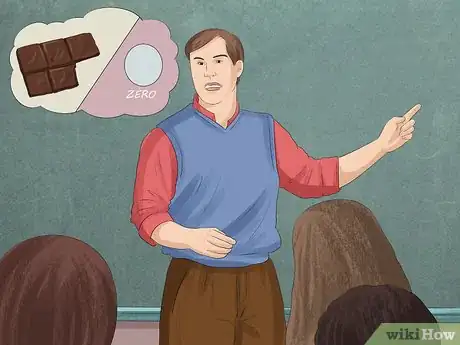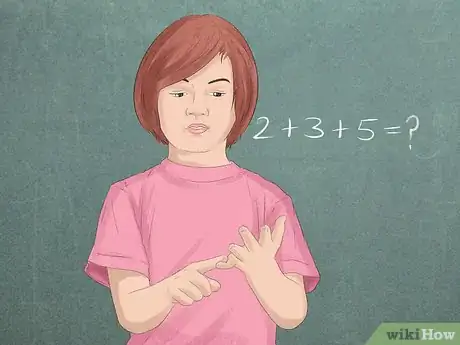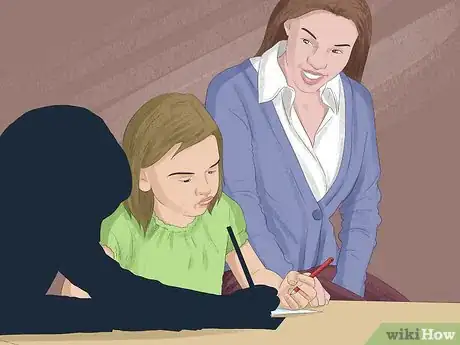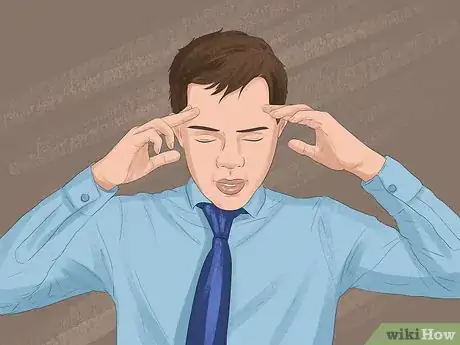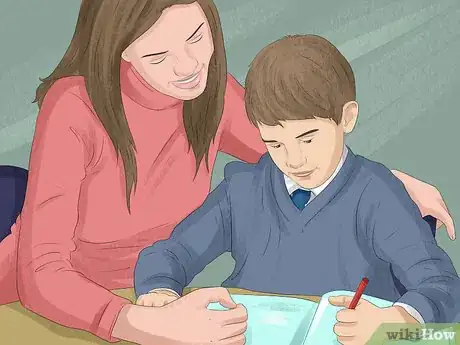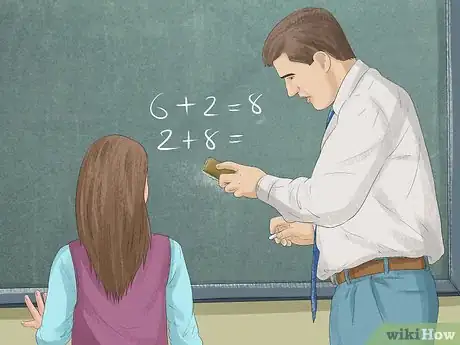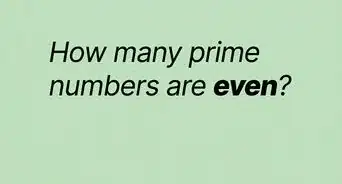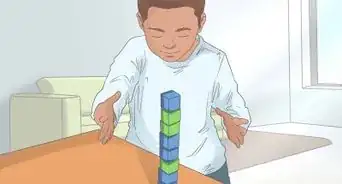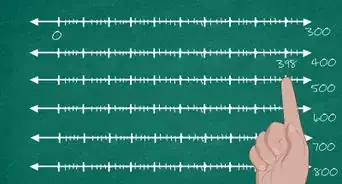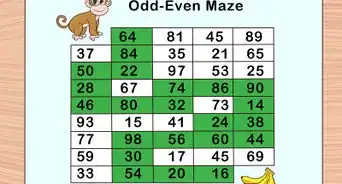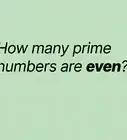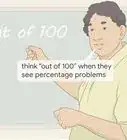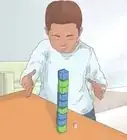This article was co-authored by Ronitte Libedinsky, MS. Ronitte Libedinsky is an Academic Tutor and the Founder of Brighter Minds SF, a San Francisco, California based company that provides one-on-one and small group tutoring. Specializing in tutoring mathematics (pre-algebra, algebra I/II, geometry, pre-calculus, calculus) and science (chemistry, biology), Ronitte has over 10 years of experience tutoring to middle school, high school, and college students. She also tutors in SSAT, Terra Nova, HSPT, SAT, and ACT test prep. Ronitte holds a BS in Chemistry from the University of California, Berkeley, and an MS in Chemistry from Tel Aviv University.
There are 9 references cited in this article, which can be found at the bottom of the page.
This article has been viewed 83,726 times.
For many, math is a very intimidating and challenging subject. For others, it is a straightforward exercise in logic. As a teacher of math, you are likely to encounter students of both categories. Whether you are teaching young children or older students, it is good to have a variety of methods for explaining and practicing math concepts. Remember to be patient and encouraging, and you will help students of all skill levels to learn that math is not something to be afraid of, but a subject to get excited about.
Steps
Teaching Math Concepts
-
1Introduce a new concept and explain its usefulness. When teaching math, you will be teaching one new concept at a time, since math builds on itself.[1] For example, you might be teaching students how to do multiplication. Therefore, begin by introducing the topic of multiplication. Give them examples of how they will use multiplication in their daily lives, even when they are out of school.[2]
- It may be useful, when you are trying to explain the importance of a math concept, to include a demonstration. For example, if you are teaching division, and you want to demonstrate how they will use it in their daily lives, you could bring a batch of cookies (make sure you have a number that is divisible by the number of students. If you have 12 students, bring at least 24 or 36 cookies, so that it will be easy for them to understand). Tell the students you have brought cookies, but you don’t know how many each student should get. Ask them to help you think of ways to figure it out, and then introduce the concept of division.
- Watch for opportunities in your everyday life to point out the usefulness of math. For example, you might share with your student how you use math at the grocery store to estimate the cost of weighed fruits or vegetables, or you might show them that you use math while adjusting a recipe.
-
2Break it down into steps. You can begin by explaining a broad mathematical principle to the student, but then break it down into the smallest steps possible.[3] This will help the student understand why you are doing it the way you are doing it, and therefore, will help them learn and remember how to do it on their own.[4]
- For example, you might begin by showing a student that 2x3=6 but then show them exactly how you came to that conclusion. You can explain that this problem is actually asking you to add up 2+2+2. Ask them to add those numbers up so that they can see that multiplication is just a shorter way of asking you to add one number a certain number of times.
Advertisement -
3Explain why. Often in math, teachers explain how to do something, but not why it is done that way. This may be fine for some students, but for most, it is difficult to grasp concepts if they do not understand why it is being done that way. Many students who can find the right answer to a mathematical problem have simply memorized the steps, but have not actually understood the reasons why a particular concept works the way it does. Unless they understand the theory behind the problem, they are likely to forget it very quickly.[5]
- You could, for example, explain who came up with this method, and the logic that was used to create the method. With younger children, though, it is unlikely that this will be useful. If you want to explain the theory, try to make it visual and interesting. Try to tell a story about how the math concept came to be.
- Be patient when doing this. Inquisitive students may ask many questions about your “why” explanation. Take the time to answer each question as best you can, and if you don’t know, find out together. If it is in a classroom situation where you can’t find the answer immediately, ask them to come see you after class so you can have a look.
-
4Give a simple example and go through it step-by-step.[6] Once you have introduced the concept, and explained the different steps involved in doing the calculation, provide a simple example. Show them how you figure it out step-by-step. If you are teaching to a classroom of students, use the blackboard to write out the problem, then use a different color piece of chalk (or marker) to show them each step involved in the calculation.
- Be sure when you are doing this that students have opportunities to ask questions about each step you are performing. If you normally require students to raise their hands to ask questions, now may be a good time to let that rule slide. This will allow them to stop you as soon as you have a question.
- Whenever possible, give the student a physical object to help them conceptualize the problem. This could include small items, such as beans or poker chips, that they can manipulate. For example, your student could work through the problem 20/4 using 20 poker chips. They could divide the poker chips into 4 piles, which would show that there are 5 chips in each pile.
-
5Give a more difficult example. If the students don’t have any more questions once you have shown them the simple example, move on to a more difficult example problem. Instead of just showing them how to do it, ask them to guide you.
- If they make a mistake when guiding you say something like, “I can see why you think that’s the next step, but don’t forget about…” and then explain what they’ve forgotten or gotten mixed up.
-
6Introduce any exceptions to the rules. In some mathematical concepts, you will come across concepts that typically work in a certain way, but have specific exceptions. These types of concepts, especially, require that the student truly understand how the concept works. They are unlikely to remember or be able to figure out when the exception applies if all they’ve done is memorized the steps.
- For example, in division, you can divide any number by another number to get some kind of answer. However, you cannot divide any number by 0. This is because you can’t, for example, split 5 pieces of chocolate among 0 friends.[7]
-
7Practice. The students will get better at understanding the concepts if they are given several opportunities to practice the material.[8] You can even space the practice material out over weeks or months so that the student returns to the same material at various intervals, which will reinforce what they’ve learned.[9]
- If possible, mix up the practice exercises with straightforward worksheets (e.g. a page with 25 long-division worksheets where you ask the student to show their work on each problem) as well as real world problem solving exercises. For example, the following problem will ask the student to do long division, but in a real world setting: "Each week you will need to work 26 hours. The work week is 5 days. How many hours will you need to work each day in order to meet the 26 hour requirement? Assume that you need to work the same number of hours each day." Ask the student to tell you the answer. If they get it wrong, ask them to do the work on paper so you can see where they went wrong.
- Incorporate math practice into your everyday life, creating a routine. Ask your student to add up how much groceries will cost, or to help calculate how much of something you need.
-
8Assess the student’s progress. Once you have explained, worked through problems together, and practiced a specific concept, you should test the student’s understanding of the concept. Depending on the setting of your teaching, you may simply provide them with a few problems to complete so you can see which questions they get wrong and which they get right, or you might have to conduct testing that will determine a grade point average for the course.
- Regardless of the type of assessment you use, it is important to go through the student’s test and discuss with them the problem areas they have. It can be valuable for the student because it may simply be one small thing that they have misunderstood.
Using Strategies to Teach Young Children Math
-
1Use visual examples and stories to explain new concepts. When teaching math to young children, it is a good idea to use very visual examples. This will help the children imagine what you are saying in their minds so that math isn’t an abstract concept, but instead is a very clear part of real life.[10]
- For example, ask the children to help you figure out the following problem: “5 turtles crawled onto a giant rock, but then 1 got too hot, so he decided to go for a swim. How many turtles are left on the giant rock?” You can ask the children to make a drawing of the turtles to make the activity even more fun.
-
2Have the children act out the math problems. Like acting the problem out using visual examples, having children use their bodies will make math less abstract, as abstract concepts are usually difficult for children to understand.[11]
- You can ask them to count the legs of all the children in the room and add it together. You can also ask them to answer questions by showing the correct number using their fingers. For example, if you ask, “Do I have 3 arms or 2 arms?” Then ask the children to show you how many arms you have using their fingers.
-
3Involve imaginative games to make learning math more fun. Setting up games and allowing children to play while learning will make math a fun and interesting subject for young children. This will help them to be less afraid of a challenging subject.[12]
- For example, you can have them set up a shop in the classroom. You can use monopoly money, and have some students be shoppers and other children be cashiers. Use toys or other things you have around the classroom, and assign everything a price. Then allow the shoppers to choose one or two items that they will take to the register. Help them to add the total price of the items (e.g. one item costs $1 and another costs $2. Ask them to help you figure out how much both items cost together). Once they have done this, have them hand the cashier some money, and help the cashier to calculate the change (e.g. if the total cost of the items is $3.00, and the shopper gave him $5, how much change should the shopper receive?)
-
4Ask children to use critical thinking skills. You don’t always have to just show them how to do something. You can start out by asking them to think about how they would figure out a problem. This will help them to develop and enhance their own problem solving skills, and show them that math is simply a matter of thinking critically about how to solve a problem.[13]
- For example, have them all sit down at a table, and say that it’s time for snacks, but that you don’t know how many snacks to bring to the table. Ask the students to tell you how to figure it out. When they tell you, you can make the problem harder by saying that 3 extra guests will be coming. How should you figure it out now?
-
5Use computer based math programs. Most children love to play computer games, and while this shouldn’t be the main learning mode, allowing children to play math-based computer programs is a fun way to reinforce what they’ve learned.[14]
- Many of these programs also provide assessments, which will allow you to see what concepts a given student might be struggling with.
-
6Have them practice often. You can incorporate things that the children are learning spontaneously throughout the day. This will help them understand that math is something that is always important, and not just something they spend 1 hour each day trying to understand.[15]
- For example, if young children are learning to count, you can have them count the number of students present in a morning circle. During clean up, you can ask the children to only clean up 10 of the items on the floor.
-
7Be patient and encouraging. When you are teaching young children, you give them what might be their first experience with math. This is where they will either learn that math is something interesting and useful, or that they are one of those people who aren’t good at math. Try to dispel this myth early on by showing children that math is something that everyone can learn.[16]
- Studies show that young girls especially tend to believe that they are not talented enough for math, which offers one explanation for why fewer girls tend to pursue math related careers. This is despite the fact that there have been no significant differences demonstrated in actual ability between girls and boys.[17] While you shouldn’t show favoritism towards girls, you should make sure that it is clear that math isn’t a “boy subject”.
Introducing More Complicated Math to Older Students
-
1Refresh your memory. Even if you are a seasoned math teacher, you may not be up to date on new methods and techniques for solving a certain problem. Therefore, before you begin to teach a new concept, take a few hours to refresh your memory on the theory behind the concept. Read about any new methodologies that may be used to solve a particular problem.
- This will ensure that you are ready for the many, many questions that students may have. It may also give you new ideas and examples to help students learn.
-
2Encourage the student. For some reason, in the subject of math, students get the idea in their head that they either are good at math or they aren’t. While math may come more quickly to some than to others, with the right tools, anyone can learn the math skills they need to become successful.[18] Therefore, you should encourage your students, and don’t let them believe they are just “bad at math.”
- If one of your students say, “I just don’t get it. I can’t do math, and I will never learn this.” You can reply with something like, “I know this is a challenging topic, but it’s not true that you can’t do math because, just like everyone can learn to read, everyone can learn to do math. Let’s try approaching this topic in a different way.”
-
3Avoid scolding a student for giving the wrong answer. If the student is made to feel bad about giving a wrong answer, they are unlikely to want to give any more answers. Therefore, you should avoid scolding them or making them feel stupid for trying.[19]
- If they get the wrong answer, ask the student to show you how they came to that answer. This way, you will be able to show them exactly where they went wrong.
-
4Involve the student in the learning process. When you are teaching them something new, find a real world problem that is related to the concept you are teaching, and ask them to think about and tell you how they might solve it before you explain each step. This will help the student feel a sense of involvement and accomplishment when you both get to the method you are teaching together.[20]
- For example, if you are teaching students about least common multiples (which refers to the lowest quantity that is a multiple of two or more numbers), give them a real life example, where they are a manager trying to schedule a meeting with 5 colleagues. Give them the availability of the 5 colleagues, and ask them how they would figure out when the best time to hold a meeting would be.
- Not only does this allow them to become engaged in the problem, it also demonstrates how math is important in the real world. This is good because many students believe that they won’t use the math they learn in the real world.
-
5Have a few teaching strategies in mind. If you are working one-on-one with a student, you can plan to teach the subject with that particular student in mind. For example, if you know the student you are working with needs visual examples, you can incorporate videos or stories to help them. However, if you are teaching to a classroom of students you will have different students with different ways of learning and understanding. Therefore, be prepared to explain a single concept in several different ways.[21]
- Have visual explanations such as YouTube videos ready to go, have real world problems prepared, and of course, have a more theoretical explanation of the concept for those who tend to learn best simply through direct lecturing.
Community Q&A
-
QuestionWhat is the best method for teaching mathematics?
 Ronitte Libedinsky, MSRonitte Libedinsky is an Academic Tutor and the Founder of Brighter Minds SF, a San Francisco, California based company that provides one-on-one and small group tutoring. Specializing in tutoring mathematics (pre-algebra, algebra I/II, geometry, pre-calculus, calculus) and science (chemistry, biology), Ronitte has over 10 years of experience tutoring to middle school, high school, and college students. She also tutors in SSAT, Terra Nova, HSPT, SAT, and ACT test prep. Ronitte holds a BS in Chemistry from the University of California, Berkeley, and an MS in Chemistry from Tel Aviv University.
Ronitte Libedinsky, MSRonitte Libedinsky is an Academic Tutor and the Founder of Brighter Minds SF, a San Francisco, California based company that provides one-on-one and small group tutoring. Specializing in tutoring mathematics (pre-algebra, algebra I/II, geometry, pre-calculus, calculus) and science (chemistry, biology), Ronitte has over 10 years of experience tutoring to middle school, high school, and college students. She also tutors in SSAT, Terra Nova, HSPT, SAT, and ACT test prep. Ronitte holds a BS in Chemistry from the University of California, Berkeley, and an MS in Chemistry from Tel Aviv University.
Academic Tutor The best method for teaching math is going to be laying out the steps for each concept and practicing that until your students have a solid foundation. Math is really a sequential subject, so ensuring your students have a solid understanding of the steps they need to know before you move on will be really helpful.
The best method for teaching math is going to be laying out the steps for each concept and practicing that until your students have a solid foundation. Math is really a sequential subject, so ensuring your students have a solid understanding of the steps they need to know before you move on will be really helpful. -
QuestionHow do you motivate a child in math?
 Ronitte Libedinsky, MSRonitte Libedinsky is an Academic Tutor and the Founder of Brighter Minds SF, a San Francisco, California based company that provides one-on-one and small group tutoring. Specializing in tutoring mathematics (pre-algebra, algebra I/II, geometry, pre-calculus, calculus) and science (chemistry, biology), Ronitte has over 10 years of experience tutoring to middle school, high school, and college students. She also tutors in SSAT, Terra Nova, HSPT, SAT, and ACT test prep. Ronitte holds a BS in Chemistry from the University of California, Berkeley, and an MS in Chemistry from Tel Aviv University.
Ronitte Libedinsky, MSRonitte Libedinsky is an Academic Tutor and the Founder of Brighter Minds SF, a San Francisco, California based company that provides one-on-one and small group tutoring. Specializing in tutoring mathematics (pre-algebra, algebra I/II, geometry, pre-calculus, calculus) and science (chemistry, biology), Ronitte has over 10 years of experience tutoring to middle school, high school, and college students. She also tutors in SSAT, Terra Nova, HSPT, SAT, and ACT test prep. Ronitte holds a BS in Chemistry from the University of California, Berkeley, and an MS in Chemistry from Tel Aviv University.
Academic Tutor Give the child lots of encouragement and tell them you believe in them. Try to help them see math as a skill they can learn, even if it's hard for them.
Give the child lots of encouragement and tell them you believe in them. Try to help them see math as a skill they can learn, even if it's hard for them. -
QuestionHow do you explain a math problem?
 Ronitte Libedinsky, MSRonitte Libedinsky is an Academic Tutor and the Founder of Brighter Minds SF, a San Francisco, California based company that provides one-on-one and small group tutoring. Specializing in tutoring mathematics (pre-algebra, algebra I/II, geometry, pre-calculus, calculus) and science (chemistry, biology), Ronitte has over 10 years of experience tutoring to middle school, high school, and college students. She also tutors in SSAT, Terra Nova, HSPT, SAT, and ACT test prep. Ronitte holds a BS in Chemistry from the University of California, Berkeley, and an MS in Chemistry from Tel Aviv University.
Ronitte Libedinsky, MSRonitte Libedinsky is an Academic Tutor and the Founder of Brighter Minds SF, a San Francisco, California based company that provides one-on-one and small group tutoring. Specializing in tutoring mathematics (pre-algebra, algebra I/II, geometry, pre-calculus, calculus) and science (chemistry, biology), Ronitte has over 10 years of experience tutoring to middle school, high school, and college students. She also tutors in SSAT, Terra Nova, HSPT, SAT, and ACT test prep. Ronitte holds a BS in Chemistry from the University of California, Berkeley, and an MS in Chemistry from Tel Aviv University.
Academic Tutor Write out the math problem, then break it down into steps. Slowly work through each step of the problem to show how to solve it. Be sure to show your work.
Write out the math problem, then break it down into steps. Slowly work through each step of the problem to show how to solve it. Be sure to show your work.
Warnings
- Remember that for many students, math is an intimidating subject. It may be extremely obvious and easy for you, but it may not be for others. Therefore, if a student approaches you for help, try to avoid making remarks that suggest that the topic should be very simple to understand. This will only discourage a struggling student even more, and it will also make you seem unapproachable.⧼thumbs_response⧽
References
- ↑ Ronitte Libedinsky, MS. Academic Tutor. Expert Interview. 26 May 2020.
- ↑ https://www.khanacademy.org/math/cc-third-grade-math/cc-3rd-mult-div-topic
- ↑ Ronitte Libedinsky, MS. Academic Tutor. Expert Interview. 26 May 2020.
- ↑ http://opinionator.blogs.nytimes.com/2011/04/18/a-better-way-to-teach-math/
- ↑ http://www.homeschoolmath.net/teaching/teaching.php
- ↑ Ronitte Libedinsky, MS. Academic Tutor. Expert Interview. 26 May 2020.
- ↑ https://www.mathsisfun.com/numbers/dividing-by-zero.html
- ↑ Ronitte Libedinsky, MS. Academic Tutor. Expert Interview. 26 May 2020.
- ↑ http://www.homeschoolmath.net/teaching/teaching.php
- ↑ http://www.scholastic.com/teachers/article/ten-creative-ways-teach-math
- ↑ http://www.scholastic.com/teachers/article/ten-creative-ways-teach-math
- ↑ http://www.scholastic.com/teachers/article/ten-creative-ways-teach-math
- ↑ http://www.scholastic.com/teachers/article/ten-creative-ways-teach-math
- ↑ http://www.scholastic.com/teachers/article/ten-creative-ways-teach-math
- ↑ http://www.scholastic.com/teachers/article/ten-creative-ways-teach-math
- ↑ Ronitte Libedinsky, MS. Academic Tutor. Expert Interview. 26 May 2020.
- ↑ http://www.ascd.org/publications/educational-leadership/sept09/vol67/num01/Encouraging-Girls-to-Pursue-Math-and-Science.aspx
- ↑ http://opinionator.blogs.nytimes.com/2011/04/18/a-better-way-to-teach-math/
- ↑ https://www.mathgoodies.com/articles/beginner_tips
- ↑ http://www.edutopia.org/blog/takeaways-math-methods-teach-effectively-jennifer-bay-williams
- ↑ http://www.edutopia.org/blog/takeaways-math-methods-teach-effectively-jennifer-bay-williams
About This Article
To teach math to young children, start by using visual examples and stories to explain math concepts. For example, you could ask, “If 5 turtles crawled onto a rock, but 1 decided to go for a swim, how many turtles are left on the rock?” Another way to help kids understand math concepts is to have children act out the math problems. For example, you could ask them “Do I have 2 arms or 3 arms?” and have them show the correct number using their fingers. For more tips from our Educational reviewer, like how to teach math to older students, read on!
